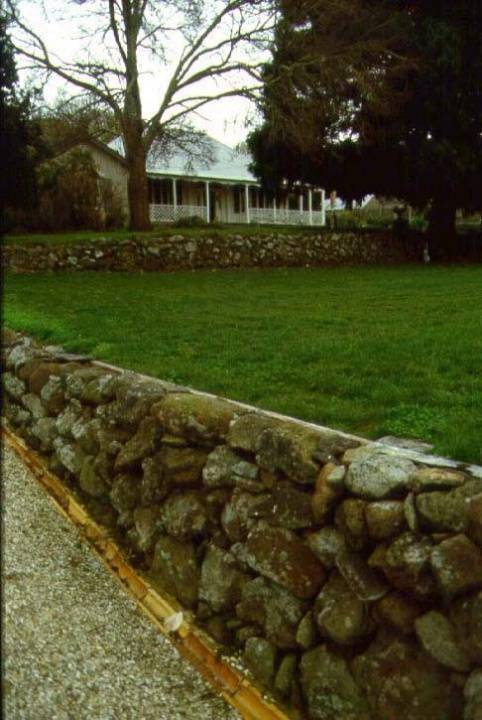| Back to search results » | Back to search page » |
|
Moranghurk Homestead and Outbuildings
LocationMidland Highway LETHBRIDGE, GOLDEN PLAINS SHIRE LevelRegistered |
|
Statement of Significance
Moranghurk homestead is of paramount importance as a rare example of the early Australian Colonial style and constructed in a vertical timber slab technique with cover battens not known elsewhere in Victoria. The homestead has significant associations with John Matheson, a prominent pastoralist and financier and his descendants for over 100 years and is evocative of the Colonial architectural traditions of New South Wales and Tasmania. The verandah and valance and unusual fenestration, are distinctive features. (The Commission is in the process of developing and/or upgrading official statements for places listed prior to Moranghurk is the remains of a large pastoral property originally called Morangourke, National Trust citation: The verandah and valence, and unusual fenestration, are distinctive features. Moranghurk homestead was extended by construction of a mid Victorian style weatherboard cottage at an unknown date. The original homestead is maintained in good condition and is externally intact. Of State significance.
1991. The above data was mainly provided by the nominator and has not yet been revised by the Commission.
[National Estate Register:
The homestead and outbuildings are of paramount importance as rare examples of the early Australian Colonial style. The homestead has been registered but the outbuildings have still to be evaluated. Database No. 3509. Indicative] Source: Victorian Heritage Register:
What is significant?
located on the Moorabool River near Lethbridge. The first squatters to occupy the run was the partnership of Dugald McPherson and William Taylor, from 1840 to 1846. McPherson and Taylor subsequently moved to Longerenong on the Wimmerra. Taylor went on to acquire several pastoral runs, and built his main home at Overnewton near Keilor in 1849. In 1847 the lease to Moranghurk comprised more than 18,000 acres, and in the 1850s it was 26,000 acres. The Soldier Settlement Commission acquired most of the land in the 1950s.
The exact date of construction of the present homestead is uncertain but is likely to be from the mid1840s. It is axially planned, and built of an adzed frame covered with hand sawn timber slabs fixed vertically with cover battens. The corrugated iron roof covering conceals an earlier shingle roof fixed over rough bush pole rafters. A substantial and unfortunate 1960s cement brick addition to the house meant the removal of part of the
verandah.
The garden is laid out to the east of the house in a squared form, including terraces, stone walls and steps, and is enclosed within a dry stone wall built in the 1920s. The gravel paths are edged by terracotta glazed spoon drains with the manufacturer's name 'Cornwell'. There is a small remnant orchard, south of which is an old garden shed that has partially collapsed. The landscape is dominated by conifers, mainly cypress and pines, and features an impressive driveway
planting of a row of Cupressus macrocarpa 'Horizontalis' and alternating Cupressus sempervirens, on the inside, now overgrow by the Monterey Cypress. West of the small driveway bridge built in 1926 is a double row of Cupressus macrocarpa 'Horizontalis', which form an impressive avenue with enclosed canopy along the drive. Beyond the gate lodge to the garden entrance is an avenue of mature Monterey Pines. A post and single rail fence, and a modern picket fence partly surround the homestead garden.
A substantial collection of historic 19th and early 20th century farm structures survive, including a picturesque hexagonal meat house. The ruined c1870 bluestone stable building contrasts to the imposing 1920s bluestone faced motor garage sited nearby. Other notable structures are the 1920s circular pump house by the river, a greyhound kennel and pens, 1920s bluestone and brick shearers quarters, and the small 1926 bridge along the driveway, with concrete balusters and rails but earlier bluestone abutments.
How is it significant? Moranghurk is of architectural, historical and aesthetic (landscape) significance to the State of Victoria.
Why is it significant?Moranghurk homestead is architecturally significant as a rare example of the early Australian Colonial style house. The construction of vertical timber slabs with cover battens is not known elsewhere in Victoria. The homestead is evocative of the earlier colonial architectural traditions of New South Wales and Tasmania. Moranghurk homestead is historically significant as one of the oldest pastoral era homesteads in Victoria. The homestead site is historically significant as a representative example of an early Victorian squatting run. The land tenure history demonstrates the familiar sequence of licensed squatting, granting of leasehold, acquisiton of a pre-emptive right and later disposal of much of the run under the auspices of the Soldier Settlement Scheme.
Moranghurk is of aesthetic (landscape) significance. The key features of the garden are the squared layout, extensive use of glazed tile drains, driveway cypress trees, the orchard enclosed by a picket fence and cypress hedge, and the pines and cypress plantings that enclose the garden. Glazed terracotta spoon drains are now rare in Victorian gardens.
The pastoral run Morangourke (now Moranghurk) on the Moorabool River near Lethbridge was taken up by Peter Sharp in March 1846. The exact date of construction of the present homestead is uncertain but apparently in the late 1840s. This axially planned house is built of sawn timber slabs fixed vertically in an adzed frame with cover battens, sapling rafters and iron roof replacing the original thatch.
Moranghurk homestead is of paramount importance as a rare example of the early Australian Colonial style, and constructed in a vertical timber slab technique with cover battens not known elsewhere in Victoria. The homestead has significant associations with John Matherson, a prominent pastoralist and financier, and his descendants for over 100 years and is evocative of the colonial architectural traditions of New South Wales and Tasmania.
Group
Residential buildings (private)
Category
Homestead building






